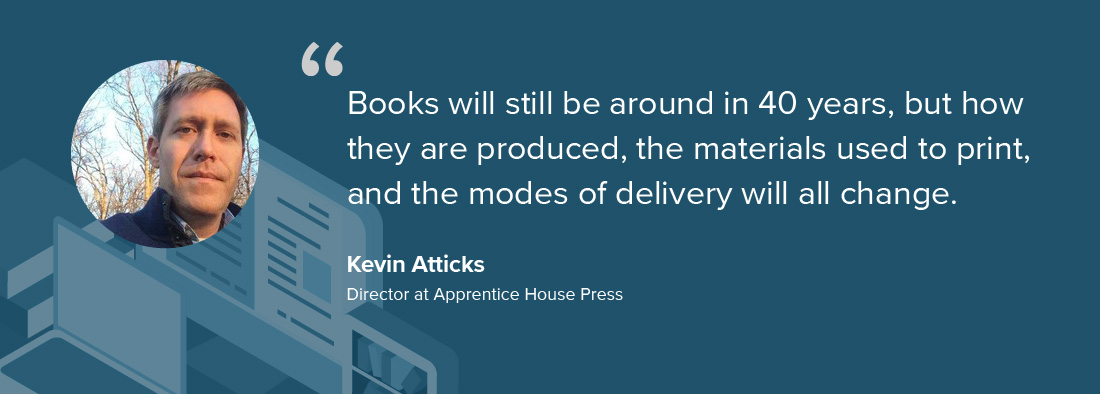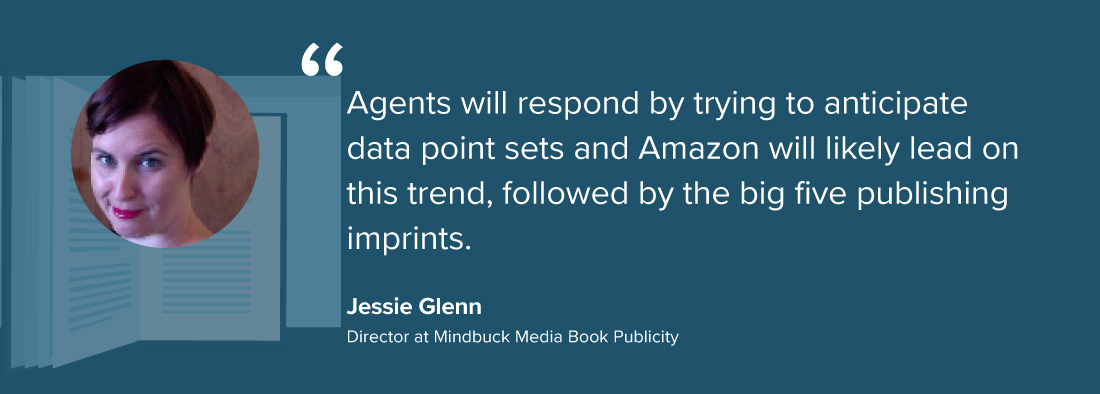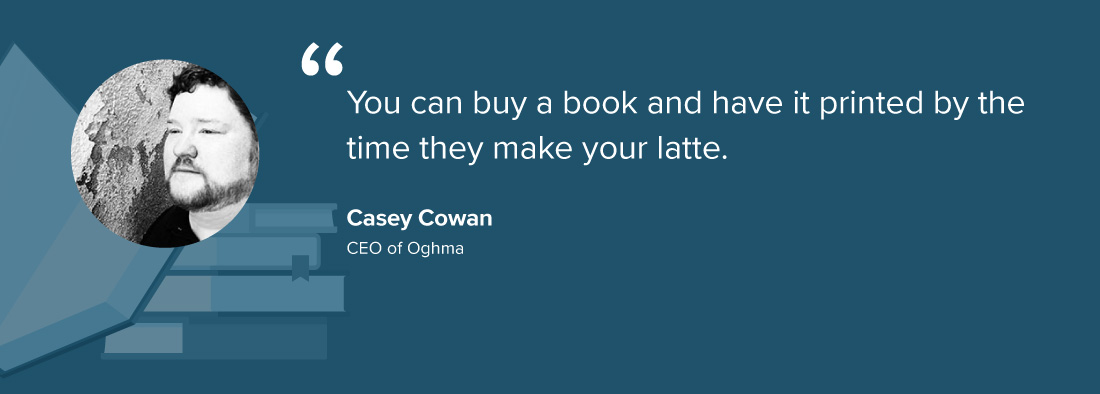A half-millennium. That’s how long books have been going strong.
When the Kindle was introduced in 2007, the publishing industry “began a multi-year panic over predictions that the digital book would replace ink on paper,” according to David Crumm, Co-Founder and Editor-in-Chief at Front Edge Publishing.
Those predictions ended up being quite wrong.
Crumm goes on to underscore the point, “Twelve years later, digital sales have receded even as book sales are stronger than ever.” E-book sales have settled at a respectable 20% of the market.

Kevin Atticks, Director at Apprentice House Press, agrees that books have staying power but also suggests that technological changes will reshape production processes. “Books will still be around in 40 years, but how they are produced, the materials used to print, and the modes of delivery will all change,” says Atticks.
Many of those anticipated changes will be driven by publishers looking to better serve the changing desires and demands of customers, as well as respond to evolving distribution and delivery models. Atticks believes that technology will enable this effort among publishers.
As a leader in the publishing industry, Crumm suggests that “the future belongs to authors with compelling stories as well as useful and inspiring nonfiction that will keep readers coming back for more.” Crumm’s prediction and the data behind it seem to suggest that while the publishing industry has certainly evolved, it also remains the same in some important ways.
Below we share and discuss predictions from industry experts about where the publishing is headed over the next 30 years.
Key predictions from publishing industry experts

Publishing goes Moneyball
The tech industry is setting the pace for the publishing industry.
According to Jessie Glenn, Director at Mindbuck Media Book Publicity, publishers will get much more sophisticated with how they make their acquisitions. In the future, according to Glenn, since they’ll rely on “complex data points rather than guessing, publishers will attempt to bring Moneyball into publishing.”
Digging into the analytics of what makes a book popular is the next level of work for publishers. Glenn predicts that “agents will respond by trying to anticipate data point sets and Amazon will likely lead on this trend, followed by the big five publishing imprints.”
Next stop: data-driven publishing.
More selective publishing routes
Rick Lite, CMO of Stress Free Book Marketing, is already seeing one major change.
“With printing costs on the rise and reseller commissions decreasing, authors are looking for other marketing avenues,” says Lite. He sees authors moving away from book writing and publishing as a way to promote their message and build credibility. According to Lite, authors are “looking for other platforms to promote and reach their followers.”
As the cost to publish and market a book rises, authors and publishers will grow more selective about what gets published and how revenue is pursued for book projects. A big player in this is Amazon, which continually drives down the retail prices of books and has forced authors and publishers to reduce eBook prices if they find a competitor selling at a lower price.
Increased cross-genre and cross-platform promotion
Movie trailers for books.
Novels accompanied by specially-curated Spotify playlists.
Authors running Twitter accounts tweeting as their book’s protagonist.
This isn’t the future of publishing and book promotion—it’s happening now. There are even food menus being created to accompany modern books.
D Gilson, a writer and university professor of writing with Expert Insurance Reviews, observes that “as more and more folks engage literature on multiple platforms, we are seeing more cross-genre or cross-platform promotion.”
Gilson predicts that as more platforms arise, we’ll see more of this cross-promotion being leveraged to “drive book engagement and sales.”
Publishers should be ready to promote books across all genres and channels to stay ahead.

Printing goes on-demand and eco-friendly
“It’s cheaper, saves money, and is better for the environment.”
That’s how Casey Cowan, CEO of Oghma, sums up the appeal of print-on-demand services. Cowan believes that print on demand will “lead to a renaissance in terms of distribution and independent bookstores, where inventory is no longer the great divide between big publishers and small press or self-publishing.”
According to Cowan, you might soon see bookstores in your neighborhood coffee shop with digital catalogs where “you can buy a book and have it printed by the time they make your latte.”. By the way Cowan tells it, print on demand sounds like a win-win-win for customers, publishers, and the environment. Print on demand means less mass printing and more selective printing at the individual customer level.
That’s one prediction that’s hard to dislike.
When it comes to eco-friendly printing, Stephen O’Brien—Sales Manager at Ovato—insists that the publishing sector is no exception to the push for greater environmental responsibility. He shares that, “The economic interests of printers, combined with customer demand for eco-friendly practices, have made print one of the most sustainable models worldwide.”
Many printers have introduced innovations such as low-carbon automated technologies at printing plants and ISO certifications that track the origins of pieces of paper. According to O’Brien, “paper of traceable origin is now an industry expectation.”
While printing hasn’t gone totally green just yet, some printers have gone greener.
Diversity becomes a bigger priority
“People are hungry to see themselves represented in books,” according to Margot Atwell, Kickstarter’s Head of Publishing.
When it comes to diversity in who runs the publishing industry and who gets depicted in books, the industry has a long way to go. Atwell points to the success of films such as Hidden Figures and Crazy Rich Asians as examples that publishers can look to in terms of “doing what’s right and seeing incredible commercial success at the same time.”
The tricky part, according to Atwell, is that publishing is a business where “editors choose and champion books which speak to them. If staff at publishing houses are not broadly representative, the books they campion likely won’t be either.”
To prevent leaving readers out in the cold, the publishing industry must tackle this central challenge: ensuring diversity.
Artificial intelligence (AI) improves content discoverability and increases profits
The team at iseek.ai has two big predictions:
AI will revolutionize how content is repurposed and deployed.
AI will help publishers drive much bigger profits.
When it comes to content discoverability, according to the experts at iseek.ai, AI will allow publishers to “analyze their entire content corpus… and easily identify what content they have already published and where there are gaps.”.
AI enables publishers to add necessary content (say, to a medical textbook for example) and avoid redundancies in other areas. Such a tool would also allow customers to discover top-performing content, which drives distribution and revenue for the publisher.
AI will also enhance profitability.
This technology will allow publishers to more deftly create, reuse, and disseminate content that sells. Take customers who want specific content within a textbook, for example, but are unwilling to purchase the entire book. AI empowers publishers to chunk content into smaller pieces and sell it at the chapter level to reach these customers.
Personalization becomes the name of the game in publishing
Sandeep Hulsandra, VP of Media Practice at Perfect Sense, knows that “audiences have moved into consuming content on different channels and platforms.”
This has forced publishers to work across a variety of outlets to disseminate information. Hulsandra insists that publishers need to develop multi-channel publishing strategies that “allow consumers to access content through mobile apps, websites, smart devices, social media, podcasts, video, etc.”
It’s all about building an omnichannel experience for customers, one that allows them to switch seamlessly between channels to access content, according to Hulsandra. With an omnichannel strategy in place, personalization is the next frontier for publishers.

Blockchain brings decentralization and new incentives
Publishing has history of hierarchical practices.
Blockchain could seriously change that model, according to Rob Giometti, CTO of Sapien.
Giometti believes that “blockchain technology will facilitate the decentralization of publishing, enabling any individual to contribute to a publication and be fairly compensated for their efforts.”
That’s good news for content creators.
Giometti also predicts that the incentive models born out of blockchain could “mitigate the propagation of fake news and fairly reward publishers for the value that they create.”
This is even better news for readers and publishers!
A better experience for contributors and publishers
As publishing technology and practices evolve, more focus will be placed on the submission experience. This becomes clear as predictions about greater emphasis being placed on personalization, data-driven strategy, and the use of AI to help customers discover best-fit content come to fruition within the industry.
Publishers will need advanced tools to improve that experience over time.
Submittable is a modern submission platform designed to make the submission process better for contributors while making it easier for publications to identify the best work.
Armed with these predictions and the right submission tools, publishers can stay one step ahead of the trends.
